Bhutan, Nepal & the Mystical Himalayas
October 5-27, 2011
NEPAL - October 13-27, 2011
Page Two - Kathmandu, Nepal
Background & History of Nepal
Nepal is a landlocked country in South Asia located in the Himalayas and bordered to the north by China and to the south, east, and west by India.
It has a population of about 30 million. Kathmandu is the capital and the largest city. Nepal has 8 of the 10 tallest mountains in the world, including Mt. Everest, called Sagarmatha in Nepal.
Hinduism is practiced by a larger majority of people in Nepal than in any other nation. However, Buddhism, a minority faith in Nepal, is linked historically with the country.
Many Nepali people do not distinguish between Hinduism and Buddhism and follow both traditions. Nepal was a monarchy through most of its history and was ruled by the Shah dynasty of kings
from 1768, when Prithvi Narayan Shah unified its many small kingdoms. A decade long Civil War by the Maoist Communist Party of Nepal and many weeks of mass protests by all major political parties
led to a 12-point agreement in November 2005. The resulting elections in May 2008 overwhelmingly favored the abdication of the monarch and the establishment
of a federal multiparty representative democratic republic.
In 1996, the Maoist Party of Nepal started an effort to replace the royal parliamentary system with a socialist republic by violent means. This led to the civil war and more than 12,000 deaths.
On June 1, 2001, there was a massacre in the Royal Palace in Kathmandu. King Birendra, Queen Aiswarya, and 7 other members of the royal family were murdered.
The alleged perpetrator was Crown Prince Dipendra, who committed suicide shortly thereafter. This massacre was alleged to have been Dipendra's response to his parents' refusal to accept his choice of wife.
To this day, there are doubts among Nepalese citizens who was really responsible. Following the massacre, the King's brother, who (interestingly) had not attended the family meeting in the Palace
where the massacre occurred, inherited the throne. In February 2005, he dismissed the entire government and assumed full executive powers to quash the Maoist movement,
but this was unsuccessful, because Maoists were firmly entrenched in large sections of the countryside, though the Maoists could not dislodge the military from numerous towns
and the largest cities. In September 2005, the Maoists declared a 3-month unilateral ceasefire to negotiate. In response to the democracy movement, King Gyanendra agreed to relinquish power to the people,
and the previously dissolved House of Representatives was reinstated in April 2006. In May 2006, it voted unanimously to curtail the power of the king and declared Nepal a secular state,
ending its official status as a Hindu Kingdom. In December 2007, Nepal was declared a federal republic and the monarchy was abolished. The Maoist Party won the largest number of seats in the Assembly
election in April 2008 and formed a coalition government. Although violence occurred during the pre-electoral period, the elections seemed to go well. In May 2008, the King was given
15 days to vacate the Royal Palace in order to re-open it as a public museum. Political tension and power-sharing battles continued. In May 2009, the Maoist led government was toppled
and another coalition government with all major political parties barring the Maoists was formed. Madhav Kumar Neapl of the Unified Communist Party of Nepal (United Marxist-Leninist)
was made the Prime Minister of the coalition government. A new Prime Minister, the Unified CPN-Maoist’s Dr. Baburam Bhattarai, was elected in August 2011.
Education is not compulsory in Nepal, although education is free through Grade 8. The literacy rate is 57% but among youth age 15-24: it is 85% male,
73% female. The work force is agriculture 73.9%; non-agriculture 26.1%. The rate of unemployment and underemployment approaches half of the working-age population.
Thus, many Nepali citizens go to India in search of work as well as to Middle East countries and Malaysia. Nepal receives $50 million
a year through the Gurkha soldiers who serve in the Indian and British armies and are highly esteemed for their skill and bravery.
Trafficking in women and child labor remain serious problems, but some small improvement has been seen. The founder of a U.S.-backed anti-trafficking organization, Maiti Nepal (www.maitinepal.org),
won the 2010 CNN Hero award. While Nepal is primarily a source country for destinations like India and the Middle East, internal trafficking is also a prominent issue.
Lack of prosecution and police complicity in trafficking cases remain major problems. Discrimination against women and lower castes is prevalent. It is common for men from India to travel to rural Nepal to
use scams (or kidnapping) to lure very young girls to India, such as promising marriage or a job. The families think the daughter is going to a better life. When the girl gets to India, she is delivered to a brothel for money.
Since the girls are not allowed to use condoms, they often get HIV, and then are dumped by the brothels. It is hard for them to return to their village in Nepal, due to their shame. The Maiti Nepal organization
is trying to help prevent the transport of Nepalese girls to India (and now China), and is helping the girls who are victims.
The actress Demi Moore teamed with CNN's Freedom Project to do a documentary
on this situation. The documentary is called "Nepal's Stolen Children" and has been shown on CNN several times.
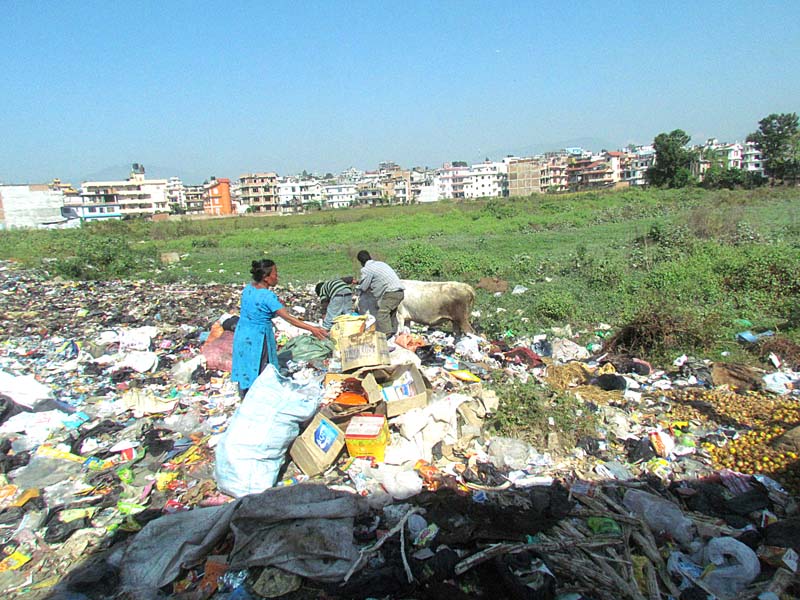
This is not a pretty picture, but it is an accurate one. Here trash has been strewn all over a field in Kathmandu. People are picking through
the trash, and a cow is feeding on it. Kathmandu is the capital of Nepal and has possibly 1 million people.
Air pollution is a serious problem in Kathmandu. Aside from the human
generated degradation produced by industry,
by extensive traffic &congestion in the city, and by frequent burning associated with its temples, including animal sacrifice and public cremations,
its location in the Kathmandu Valley means that it is subject to mountain-valley circulations which may cause air pollution circulating
away from the city to return at night, increasing pollution levels in the city in the evenings.
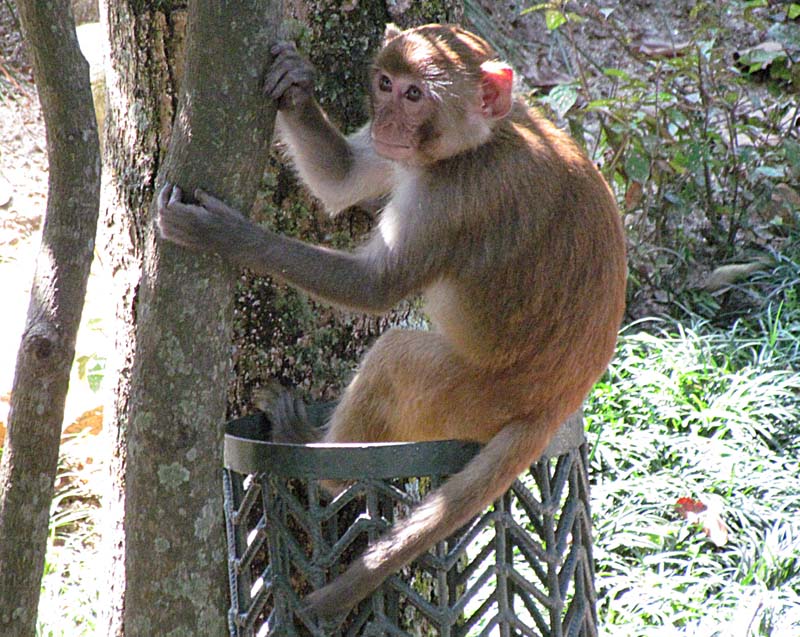
Monkeys are commonly seen in Kathmandu and surrounding areas. Here is one of many monkeys we saw at the lodge where we stayed
just outside the city, Gokarna Forest Resort. This is a rhesus monkey.
Rhesus monkeys are native to northern India, Pakistan, Nepal, Myanmar,
Thailand, Afghanistan, Vietnam, and southern China, and some neighboring areas. The Rhesus monkey has the widest geographic
ranges of any nonhuman primate, occupying a great diversity of altitudes throughout Central, South and Southeast Asia.
Rhesus monkeys may be found in grasslands, woodlands and in mountainous regions up to 8,200 ft in elevation.
They are regular swimmers. Babies as young as a few days old can swim. They are noted
for their tendency to move from rural to urban areas, coming to rely on handouts or refuse from humans.
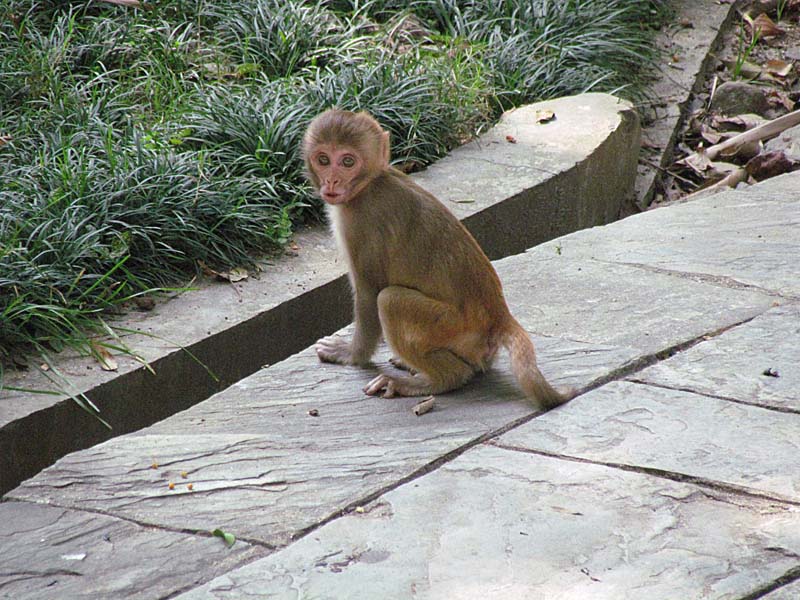
A young monkey on the walkway to the central lodge
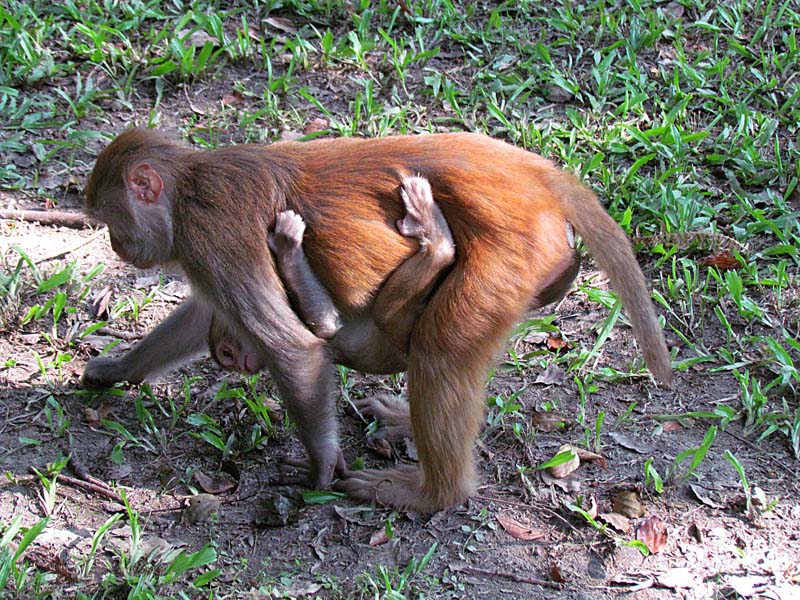
Baby clinging to Mom
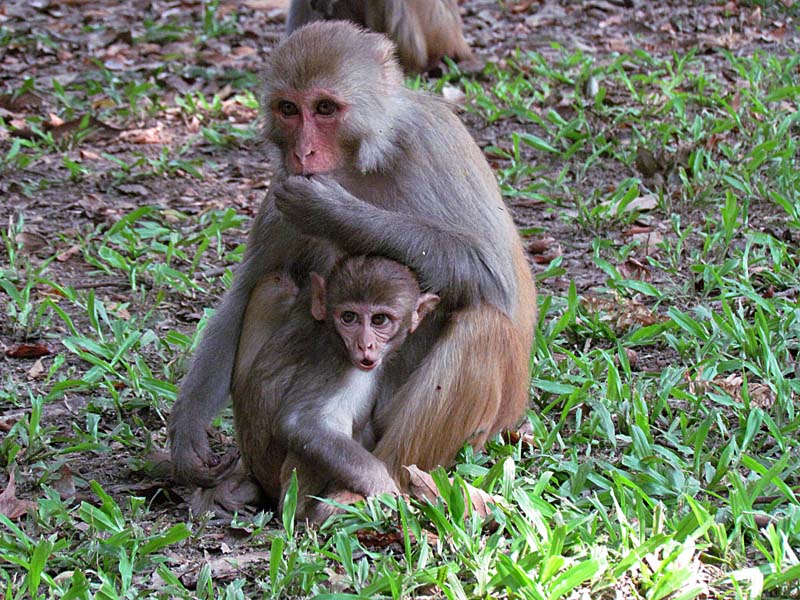
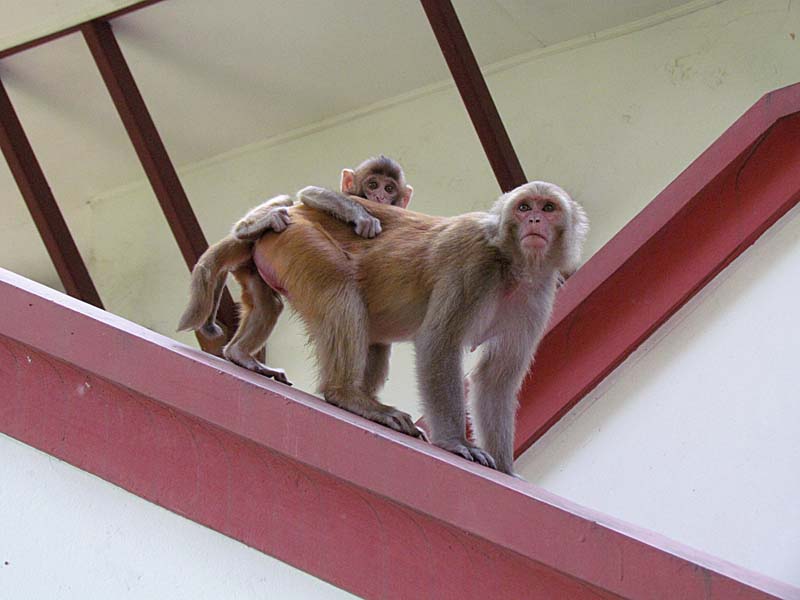
A mother and baby on the handrail just below my room at the lodge. They were looking at me as I was walking up the stairs to my
room on the second floor. They took off before I reached them. They can attack if you upset them.
We were told not to open the
screens on our room windows or to leave our room doors open, for obvious reasons.
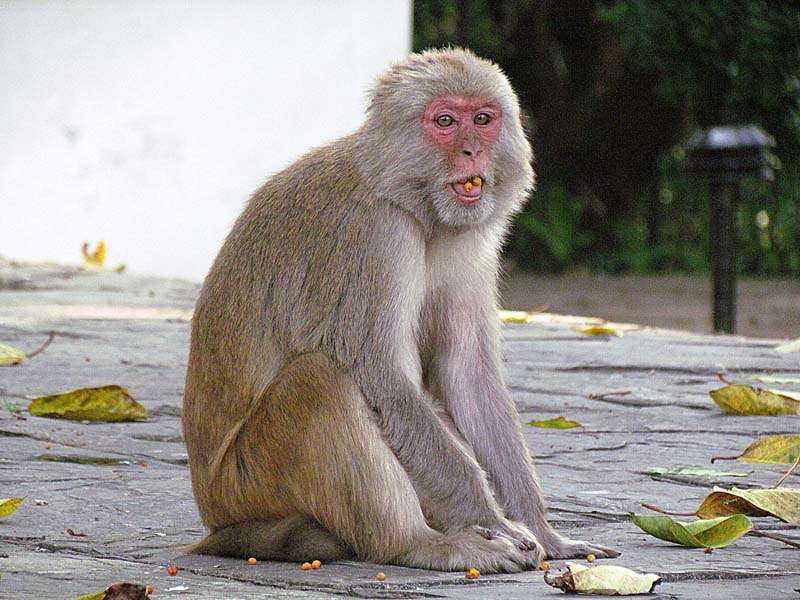
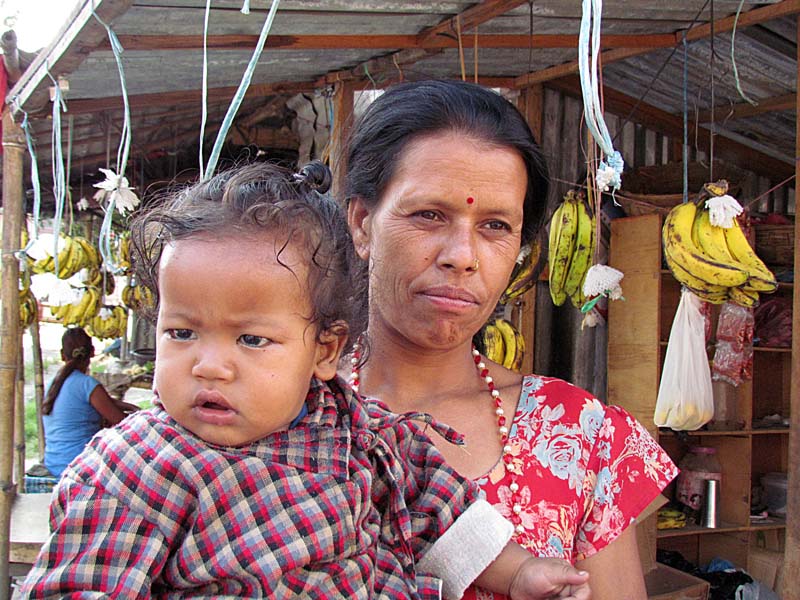
Near the lodge was a small farm village. This grandmother and baby were at a small outdoor stand selling fruits and vegetables.
The woman has a bindi on her forehead, a dot of red color applied in the center of the forehead close to the eyebrows.
Traditionally, in Hinduism, the area between the eyebrows is said to be the seat of "concealed wisdom."
It is also said to protect against demons or bad luck.
It also represents the third eye. They have also become just a decorative
item in south Asia. In Nepal, it is called a tilak, a mixture of a red powder, yogurt, and grains of rice.
The most common tilak is red powder applied with the thumb, in a single upward stroke.
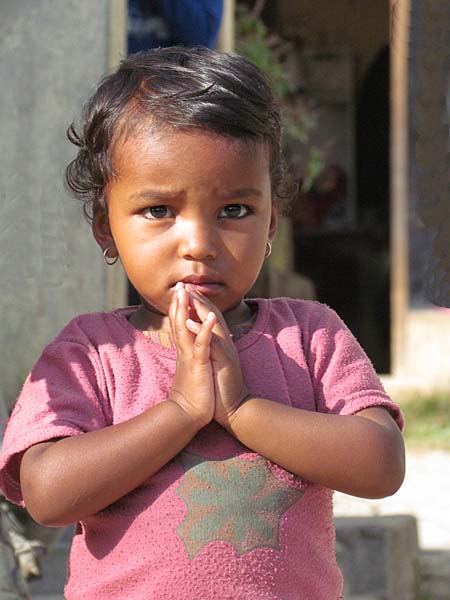
This young child has her hands folded in the typical greeting fashion. People
place their hands like this and say "Namaste" to greet you. You place the two palms together
and keep the palms in front of the chest and say the word "namaste" while bowing the head slightly.
Namaste means "may our minds meet." The spiritual significance of this practice is the belief that the life force,
the God in oneself is the same in all. Acknowledging this oneness with the meeting of the palms,
people honor the god in the person they meet.
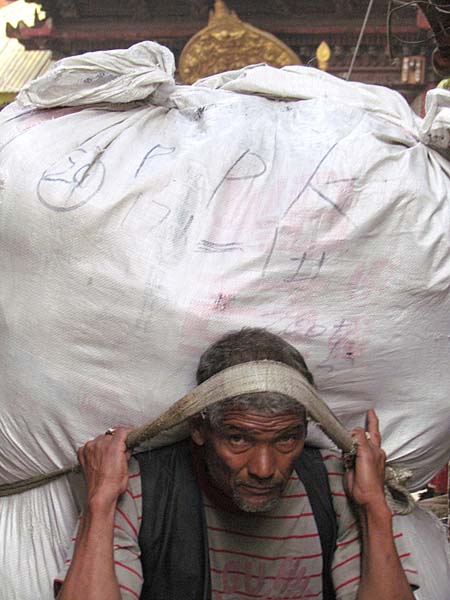
One sees men, women, and children carrying heavy loads this way throughout
Nepal, putting a band around their heads and bundles they are carrying. I was not surprised to learn that back and neck
problems are common in Nepal. This man was carrying a heavy load on a street in Kathmandu.
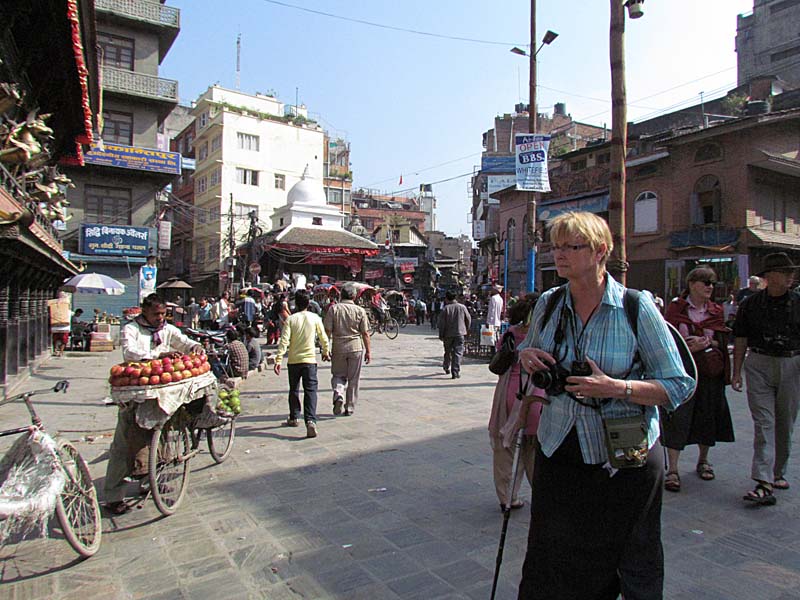
A market area in Kathmandu. The narrow streets are overflowing with people, bikes and motorcycles, some cars and trucks.
People in vehicles constantly use horns to announce their presence, so it is common to get a loud horn blast near an ear as you are walking
around. Because previous tour groups complained about how noisy Kathmandu is, the tour company switched to a lodge just outside of town
as the lodging for
Kathmandu to improve the chances of sleeping at night..
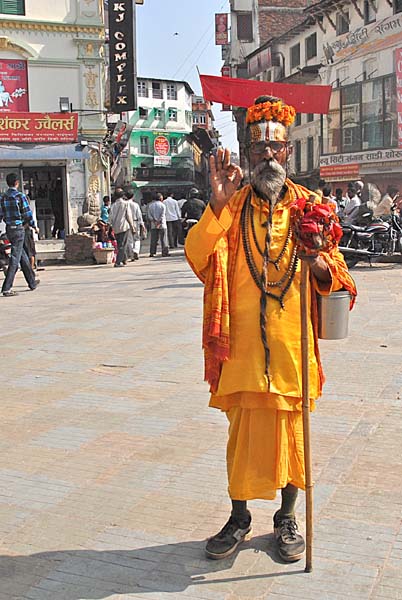
This is a Sadhu. They are often people who have decided it is time to throw everything aside
to go on a spiritual search. While many sadhus are completely genuine in their search, many
are also simply con men, hoping for money from tourists.
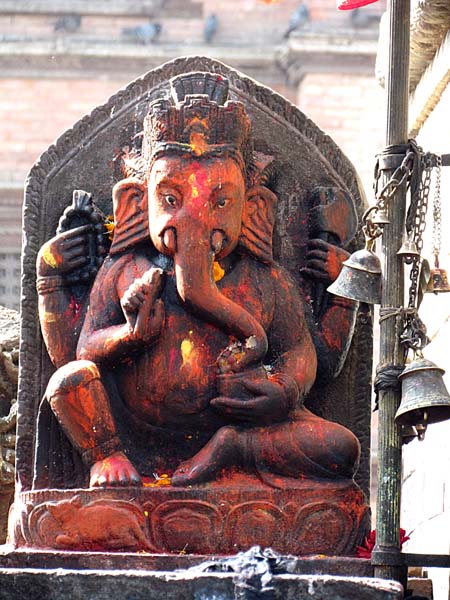
There are many gods in Hinduism. This is Ganesh, which can be recognized
by its elephant head. Ganesh is probably the most popular god, the god of prosperity
and wisdom and many offer daily prayers to him. Ganesh's parents are the god Shiva and Parvati. Ganesh got his
head due to his father's temper. Returning from a very long trip, Shiva found Parvati in
bed with a young man. Not realizing that his son might have
grown up in his
absence, he cut off Ganesh's head and then was forced by Parvati to bring his son back
to life by giving him the head of the first living thing he saw, which happened to be an elephant.
You can look upon all the millions of gods in Hinduism as pictorial representations of the many attributes of a god.
The one omnipresent god usually has 3 physical representations - Brahma is the creator, Vishnu is the preserver, and
Shiva is the destroyer and reproducer. Each god has an associated animal on which they ride, as well as a consort
with certain characteristics and abilities. Usually, each god also holds symbols. The cow is the holy animal
of Hinduism. Those who practice Hinduism believe we will all go through a series of rebirths that eventually
lead to spiritual salvation, which frees one from the cycle of rebirths. With each rebirth, you can move closer or
farther from salvation. If your deeds and actions have been good, you will reincarnate on a higher level.
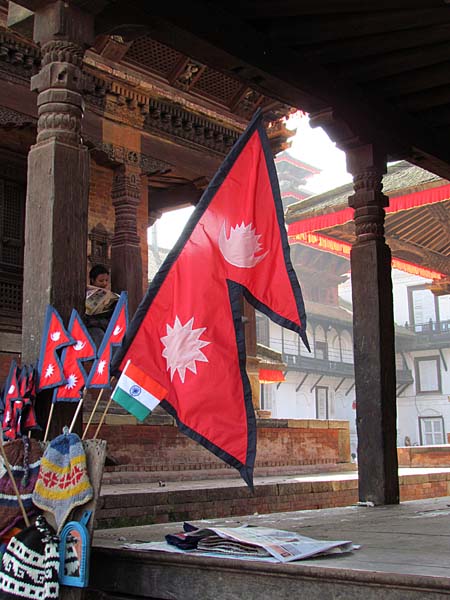
The national flag of Nepal.
The blue border symbolizes peace & harmony. The red is Nepal's national color, and it indicates the brave spirit of the Nepalese.
The two triangles symbolize the Himalaya Mountains and represent the two major religions, Hinduism and Buddhism.
The red triangular flag has been a Hindu symbol of victory for ages. The depiction of celestial bodies represents permanence,
the hope that Nepal will last as long as the sun and the moon.
The moon symbolizes that the Nepalese are soothing and calm,
while the sun symbolizes fierce resolve. The moon also symbolizes the shades and the cool weather of the Himalayas,
whereas the sun symbolizes the heat and the high temperature at the lower part of Nepal.
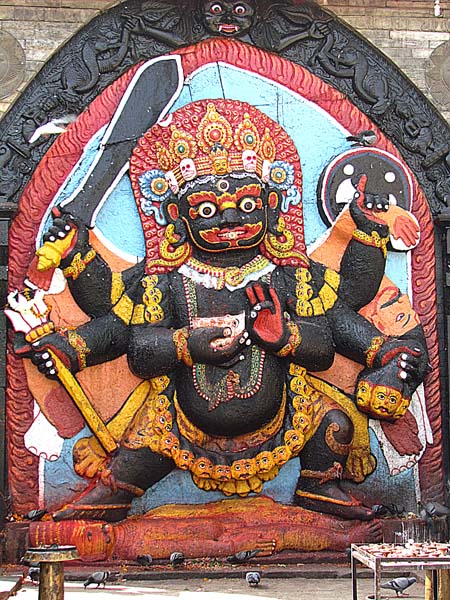
In Nepal, the god Shiva appears as Bhairab when he is in his fearful form.
Typically Bhairab has multiple arms, each clutching a weapon. He dances on a body and
wears a headdress of skulls. More skulls hang from his belt, and he has staring eyes.
Shiva is the most important god in Nepal, so it is important to keep on his good side.
This figure of Bhairab is in Durbar Square in Kathmandu.
About 86% of the Nepalese population is Hindu. One cannot be converted
to Hinduism. You are either born a Hindu, or you are not. You can never become one.
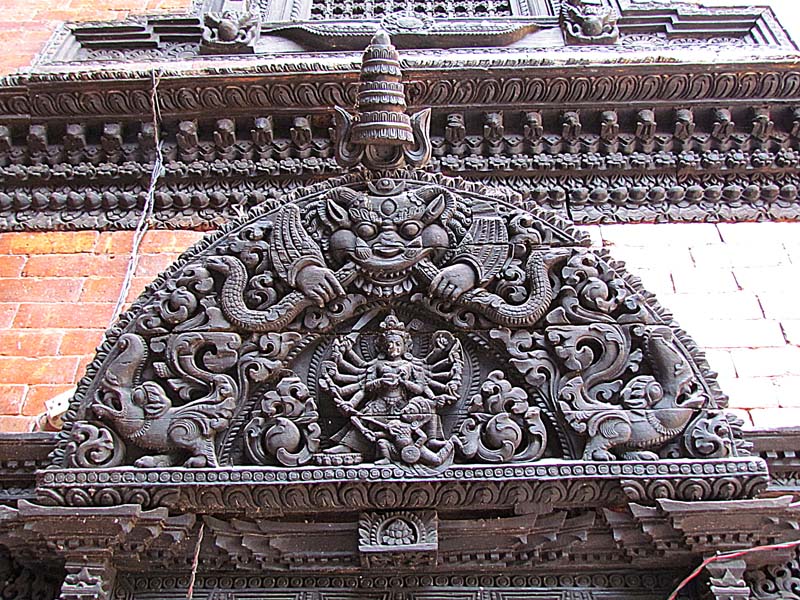
Intricate carvings like this are on structures throughout the Kathmandu Durbar Square and temples and palaces everywhere in Nepal.
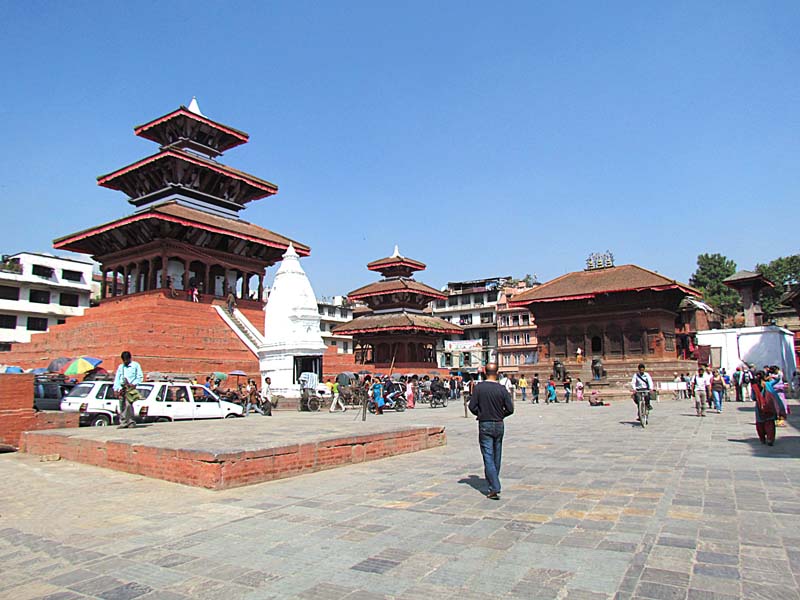
The Durbar Square of Kathmandu is located in the old city and has heritage buildings representing four kingdoms built over centuries.
The complex has 50 temples and is distributed in two quadrangles of the Durbar Square. Durbar Square literally means place of palaces.
The structure on the left is Maju Deval, a temple devoted to the god Shiva. From here, it is interesting to watch the constant activity of
fruit and vegetable sellers, the constant traffic of bikers and rickshaws, and the pleading of souvenir sellers constantly trying to get a sale.
The temple dates back to 1690. At the bottom of the temple stairway is a small temple to a companion of Shiva, built with a corncob-like spire.
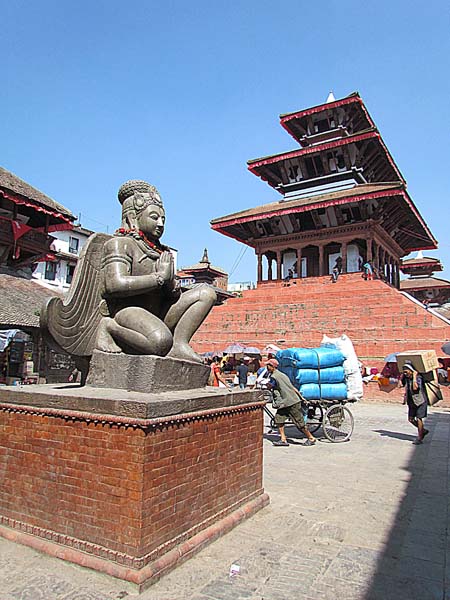
Hawkers hauling heavy loads can be seen in Durbar Square
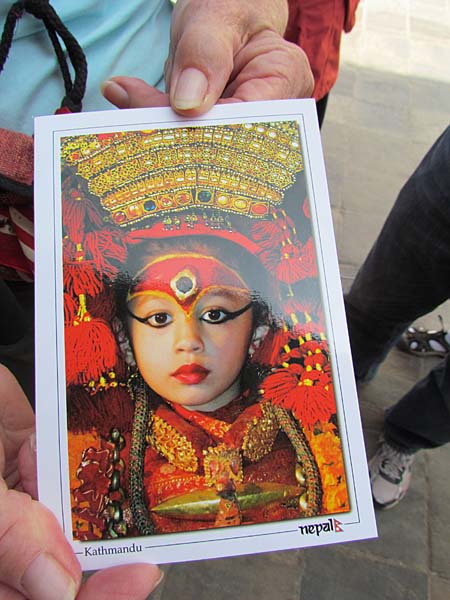
This is a postcard of Kumari, explained below. We saw her standing in a window at the palace
where she lives, but were not allowed to take her picture.
Kumari Ghar is a palace in the center of the Kathmandu, next to the Durbar Square where the Royal Kumari selected
from several Kumaris from several places resides. A Kumari must be between 3 and 5 years and come from the Newari Shakya caste.
Kumari is the result of a strange tradition in south Asian countries
of worshipping young pre-pubescent
girls as manifestations of the divine female energy. In Nepal the selection process
for her is rigorous. Kumari is believed to be the bodily incarnation of the goddess Taleju until she menstruates,
after which it is believed that the goddess vacates her body. Serious illness or a major loss of blood from an injury
are also causes for her to revert to common status and return to ordinary society. A Kumari lives in a single building that she cannot leave,
except for the dozen or so occasions when her attendance is required at ceremonial events. The current Royal Kumari, Matina Shakya,
was installed in October 2008 at age four by the Maoist government that replaced the monarchy. While she is a goddess,
she is supported by the temple income. When she no longer is a goddess, she is given a dowry.
It is believed that marrying a former Kumari is unlucky.
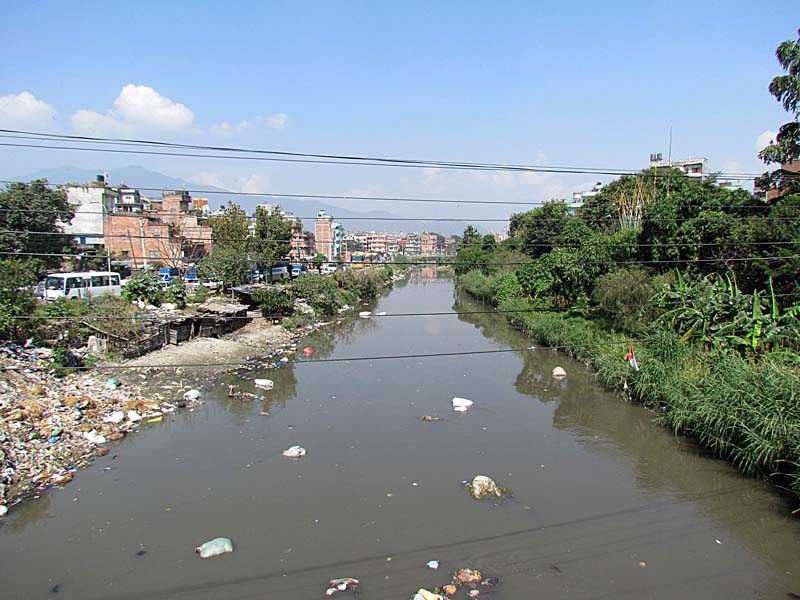
Another example of the horrible pollution in Kathmandu, a very polluted river with trash strewn both in and alongside it. There was a
dead pig floating in the river just below the bridge from which this photo was taken, which cannot be seen in this photo.
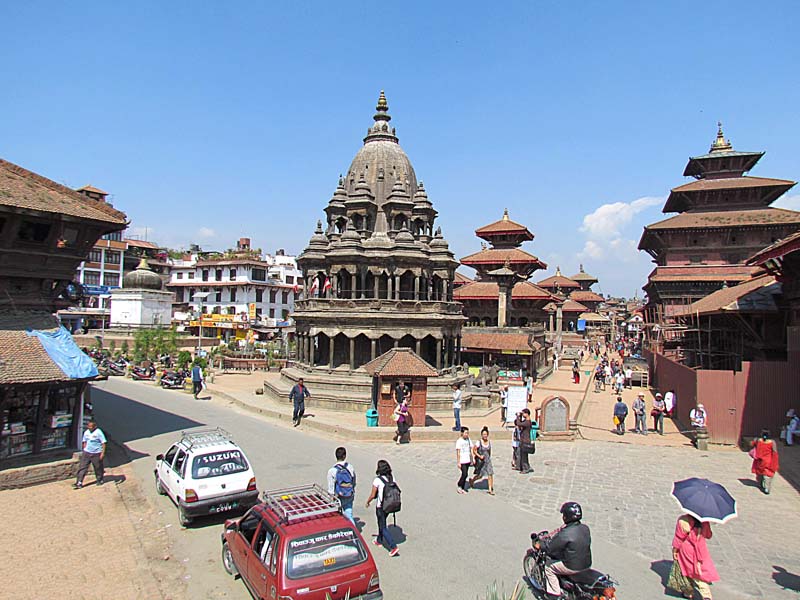
Patan Durbar Square is situated at the center of Patan, also called Lalitpur, city. It is packed with temples.
It is one of the three Durbar Squares (place of palaces)
in the Kathmandu valley, all of which are UNESCO World Heritage Sites.
One of its attractions is the Ancient Royal Palace
where Malla Kings resided. Patan is situated on an elevated
tract of land in on the south side of the Bagmati River,
which separates it from the City of Kathmandu on the northern side.
Patan is the oldest city in the Kathmandu
valley. The artworks and architectural buildings in Patan Durbar Square are from the 16th century,
but the history of Patan goes back to the
6th century.
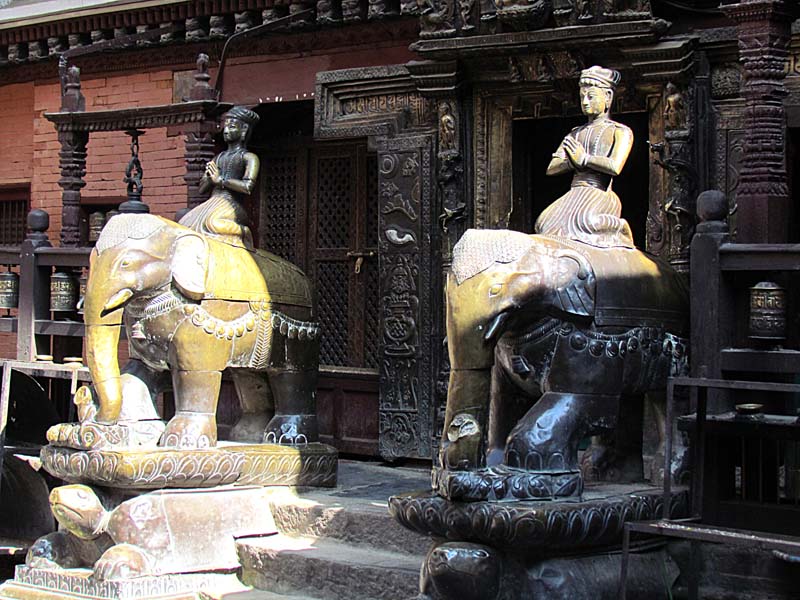
Elephants at an entrance to a temple at Patan Durbar Square
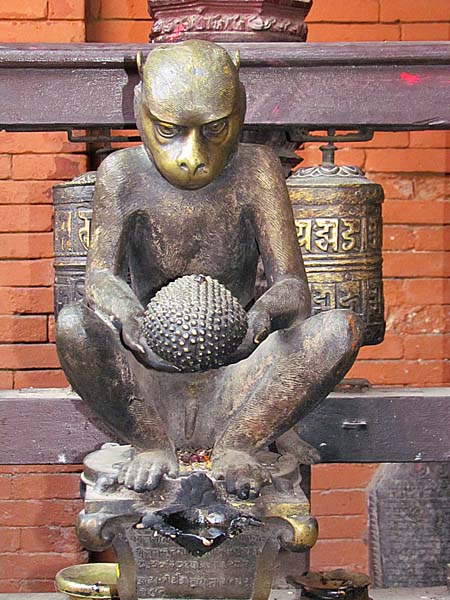
Monkey statue in front of prayer wheels at Patan Durbar Square
Hanuman, the monkey god, has an important medicinal connection in Nepal.
In Hinduism, the deity Rama is said to have sent Hanuman to the Himalayas
to find a rare herb only grown there. Hanuman forgot the specific herb he had been asked to bring back.
He made up for it by grabbing an entire mountain, sure that somewhere on the mountain would be the
required herb.
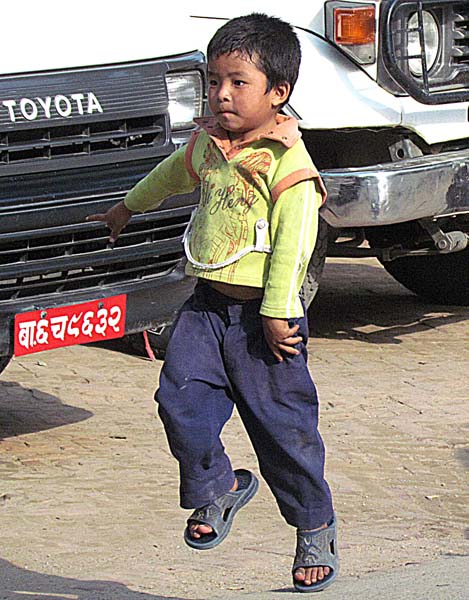
A boy skipping along the road near Patan Durbar Square
Link to Page Three - Mt. Everest Flight
Pat's Home Page